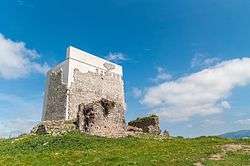Castle of Matrera
| Castle of Matrera | |
|---|---|
|
Native name Spanish: Castillo de Matrera | |
 The renovated Castle of Matrera | |
| Location | Villamartín, Spain |
| Coordinates | 36°48′26″N 5°33′56″W / 36.807256°N 5.565622°WCoordinates: 36°48′26″N 5°33′56″W / 36.807256°N 5.565622°W |
| Built | 9th century |
| Official name: Castillo de Matrera | |
| Type | Non-movable |
| Criteria | Monument |
| Designated | 1985 |
| Reference no. | (R.I.) – 51 – 0008200 – 00000 |
 Location of Castle of Matrera in Spain | |
Castle of Matrera (Spanish: Castillo de Matrera/Torre Matrera) is a medieval castle at Villamartín in Spain dating back to 9th century. It was declared a national monument in 1949[1] and an example of Bien de Interés Cultural ("Heritage of Cultural Interest") in 1985.[2] The structure underwent a controversial restoration in 2015.
History
It was built in the 9th century by Omar ibn Hafsún to defend Iptuci, the most advanced city of the Cora de Ronda. However, Mount Pajarete was a place of human settlement since Antiquity.
In the 13th century, it was conquered by San Fernando, who rebuilt it. Nevertheless, at the beginning of the XIV century, it returned to Muslim hands, being definitively reconquered by Alfonso XI in 1341. However, being located in the middle of the Moorish Border or Band was besieged by the Muslims of Granada in 1408 and in 1445.
Renovation
By 2010, only a few walls of the castle remained standing,[3] and the ruins were further damaged by rain in 2013.[4] A restoration project was launched in 2010, led by the architect Carlos Quevado, and completed in 2015. Parts of the tower were rebuilt with lime plaster similar to samples found on the site,[3] with large, plain blocks defining the original shape of the castle. Quevado described his aim as being not only to protect the ruin, but to "recover the volume, texture, and tonality that the tower would originally have had", and to differentiate new additions from the original structure.[5]
The renovation received negative reactions from some locals, with Spain's cultural heritage organization Hispania nostra calling the project "absolutely terrible".[4][6] It was praised by the architectural community, and was nominated for the 2016 Architizer A+ Award, in the Architecture Preservation category, winning the public choice vote.[3][7] The Guardian described the design as neo-brutalist, and praised it for restoring "the clout its Moorish creators originally intended".[5]
Conservation
In 2013, a large part of the tower collapsed due to the scarce work of repairing the structural problems detected decades ago.[8]
The subsequent work of preservation in 2016 with the authorization of the Junta de Andalucía was very controversial, receiving both criticism[9] and a nomination to the New York A + Architizer awards,[10] which ultimately ended up winning in the "Preservation" category.[11]
See also
References
- ↑ García, Juan. "Castillos de España en CastillosNet". Archived from the original on 30 June 2012.
- ↑ País, Ediciones El (16 April 2013). "La última bóveda del castillo medieval de Villamartín se derrumba".
- 1 2 3 "Carquero Arquitectura restores ancient Matrera Castle". 3 October 2016.
- 1 2 Jones, Sam. "'What the hell have they done?' Spanish castle restoration mocked". www.theguardian.com. Guardian. Retrieved 20 March 2016.
- 1 2 Wainwright, Oliver (10 March 2016). "Spain's concrete castle: a case of accidental genius?". The Guardian. Retrieved 21 October 2016.
- ↑ Krishna, Rachael. "This Is A Perfect Example of How Not To Restore An Old Castle". buzzfeed.com. Buzzfeed. Retrieved 20 March 2016.
- ↑ "2016 Winners – Architizer A+ Awards".
- ↑ Jerez, Diario de. "El emblema de Villamartín se derrumba".
- ↑ País, El (11 March 2016). "Polémica por la restauración del Castillo de Matrera en Cádiz" – via elpais.com.
- ↑ Cádiz, Efe. "La restauración del castillo de Matrera, finalista en unos premios de arquitectura". heraldo.es.
- ↑ 20Minutos. "La polémica restauración del castillo de Matrera gana el premio de arquitectura Architizer".
External links
| Wikimedia Commons has media related to Castillo de Matrera. |
- 'What a blunder': No magic in Spanish castle restoration, CNN, By Pietro Lombardi
- Un desastre de “consolidación y restauración”: el castillo de Matrera en Villamartín (Cádiz) (in Spanish)
- Polémica por la restauración del Castillo de Matrera en Cádiz (in Spanish)